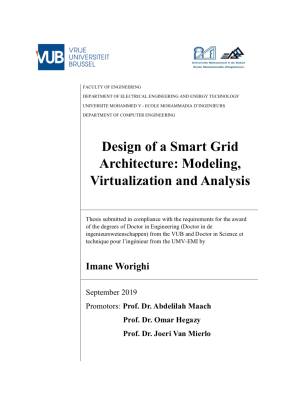
With the advent of industrialization and modernization, the world’s hydrocarbon-based energy consumption has grown rapidly, leading to an increase in annual carbon dioxide emissions, which are predicted to reach 45.5 billion metric tons by the end of 2040. The rapid rise of Greenhouse Gas (GHG) emissions is recognized as being one of the major problems facing the human race. In addition, the depletion of the fossil fuel reserves, increasing the cost of fuel for conventional power generation units, poses a challenge for the energy market. There is therefore a need to find alternative energy sources that could be renewable due to a reduction in the dependency on conventional resources and gradual transition from hydrocarbon-based sources to solar and wind sources.
Whereas wind and solar energy sources have relatively low generation costs, and high generation potential, the fluctuation of their power generation remains a tremendous challenge due to their dependency on weather conditions. A possible solution has been proposed: coupling the power system with Energy Storage Systems (ESSs). Indeed, uncertainty and the intermittent behavior of renewable power generation units impose considerable stress on power systems. To overcome this problem, ESSs could be used to feed the stored electricity back to the power system when demand exceeds generation. ESSs are also key technologies for smart grid applications and provide great opportunities for regulating frequency, Voltage Deviations (VDs), and responding to severe operating conditions. However, ESSs add additional infrastructure costs to an utterly unreasonable degree. The notion of connecting Electric Vehicles (EVs), equipped with vehicle-to-grid (V2G) technologies, to the electric grid could be a promising solution for the extra infrastructure costs. With regard to the benefits mentioned; the present thesis addresses the above challenges by proposing a novel technique. It is a combination of a new smart grid architecture, highlighting Micro-grid and Nano-grid systems, and a novel optimal design for hybrid systems, grid-connected Photovoltaic (PV) and Battery Energy Storage Systems (BESSs). Both can address sizing, siting, and charging/discharging rate problems in terms of cost and VD reduction. The proposed architectures are tested and validated by virtualization of the above technologies using use cases such as integration of ESSs, EVs, electric buses (e-buses) and renewable power generation units. Through virtualization, the SG applications can be modeled, tested and validated in a virtual system before implementation in the real system. The virtualization is therefore doubly beneficial; it is cost effective, and it reduces the need for extensive laboratory efforts before the implementation phase. In the following section, objectives and the contribution of innovation to the existing literature are set out in detail.
The present thesis was conducted in a collaborative framework between the VUB and theUMV-EMI universities. A novel smart grid architecture consisting of multiple Micro-grids and Nano-grids was proposed and modeled by means of a System of Systems (SoS) technique to depict actors, incorporating their roles and interactions within a smart grid. The proposed architecture highlights the use of controllers for smart appliances at home to tackle rising consumer bills and emphasizes the beneficial role of ESSs which can act not only as loads but also as generations. Furthermore, a Micro-grid model fed by solar energy was suggested. The cost-effective integration of renewable energy sources was studied, and the proposed model and architecture were validated with simulation analysis to resolve issues related to peak shaving, and ancillary services by utilizing ESSs.
In addition to the line, there was specific focus on V2G, smart integration into the grid system and a smart parking charging infrastructure. A use case of electric parking-lot integration into the grid was implemented and V2G and Grid-to-Vehicle (G2V) models were developed to provide ancillary services at a low voltage level. In addition, a novel Binary Integer Genetic Algorithm (BIGA) for optimal placement of parking lots was developed and equipped with a controller applied to the Plug-in Hybrid Electric Vehicles (PHEVs) batteries in order to schedule the charging and discharging for each PHEV with different departure and arrival patterns. A novel hybrid control approach combining the Fuzzy Logic Controller (FLC) and the Genetic Algorithm (GA) was developed for the use case, for optimal sizing of the combined Renewable Energy Sources (RES) and ESS to optimize size and charging/discharging of EVs, to minimize VD and Total Cost of Ownership (TCO). A sensitivity analysis of the complete system was also conducted to highlight and assess the profitability and high dependency of the optimal system configuration on battery prices. Besides that, since the electrification of the public transportation sector using Electric bus (e- bus) has a significant impact today on urban systems, special attention will soon be given to reducing the environmental impacts of transportation systems by shifting to clean fuels, while improving energy efficiency. A use case of fast charging strategy of an e-bus fleet has been considered in the grid system for one bus-line in Brussels, where its impact on the grid, especially at Medium Voltage (MV) and Low Voltage (LV) networks, is being studied. In this thesis, the implementation of a Static Synchronous Compensator (STATCOM) in both the MV and LV networks has been proposed as a solution for the maintenance of grid performance and voltage stability and to deal with the overloading caused by the power fed from the grid to the e-bus with high power level. Moreover, it was demonstrated that the proposed solution could reduce the VD by more than 2% within the boundaries of standard of VD.
The advanced smart grid models, use cases and control strategies proposed during this PhD work can be considered as a step forward, towards a new generation of smart electric grid architecture with high integration of RESs, EVs, e-buses and their charging infrastructure.
